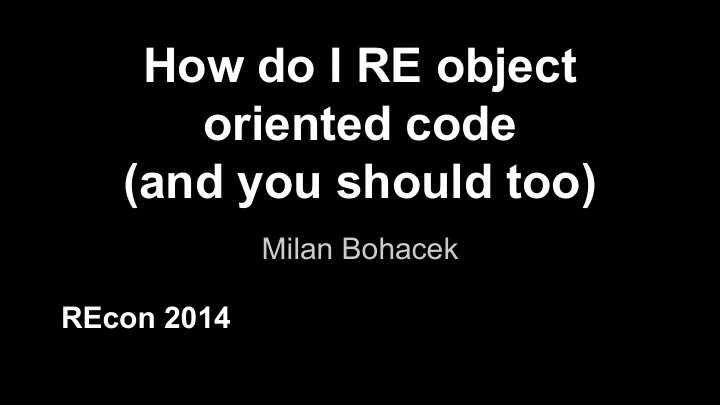

How do I RE object oriented code (and you should too) Milan Bohacek REcon 2014
.short bio Milan is ● PhD student at Charles University in Prague ● Part time malware analyst at avast! software ● IDA enthusiast ● without working laptop :-(
.apology here should have been great presentation with many pictures and live demo but my PC was against that idea :-(
.my usual line of work 1. unpack a binary 2. analyze it using Hex-Rays 3. find used cryptography 4. use algebra / common sense to check for bugs in the cryptography 5. ??? 6. profit
.definition Object-oriented programming (OOP) is a programming paradigm that represents the concept of "objects" that have data fields (attributes that describe the object) and associated procedures known as methods. Wikipedia
.definition Reverse engineer’s worst nightmare. Milan
.challenge Compile / get your favourite OO code and post a link on twitter with hashtag #reconmtl. No malware, no obfuscation, no monkey business, < 50KB, x86 || x64 || arm. I will try to look at it if I have time. No
.basic workflow 1. open a function in hex-rays 2. identify this pointer 3. create a structure that reflects memory access relative to this pointer 4. find all functions that also have this as an argument 5. goto 1. 6. merge all generated structures into one (demo) I’m getting tired just by looking at this list.
.solution! IDA plugins FTW! 1) IDA had “Create new struct type” 2) So I RE the way this worked and added more features 3) I ended up with a few “hacks”
.solution! #if IDA_SDK_VERSION <= 610 template <typename T, int addr> class C { public: T * call; C():call((T*)addr){}; T* operator()() { return call; } }; extern C<qstring __cdecl (tinfo_t *a2, int offset), 0x17035E90> create_field_name; ... #endif
.solution And this worked, but only for me. (Every IDA user has private build) Then I bugged Ilfak until he exported the functions I wanted.
.workflow with hexrays_tools 1. open a function in hex-rays 2. select this pointer 3. let the plugin gather all informations about an object pointed to by this pointer 4. ask the plugin for next function to scan 5. Once you gathered enough information let the plugin create the final object structure. (demo)
.caveats ● simple assignments - easy to solve ● structures inside structures ● virtual tables ● negative offsets
.easter eggs REcon 2013 HexRaysCodeXplorer Aleksandr Matrosov & Eugene Rodionov https://raw.githubusercontent.com/REhints/HexRaysCodeXplorer/master/img/6.png HRCX screenshot contains comments generated by hexrays_tools. Most probable cause is the presence of hexrays_tools. plw in their ida\plugins directory.
.QA questions anyone?
.end Thank you for your attention! Thanks Igor for providing me with his laptop. Arnaud for promptly fixing bugs I find. Ilfak for being awesome.
.contacts milan.bohacek+re2014@gmail.com
Recommend
More recommend